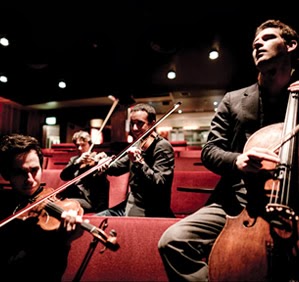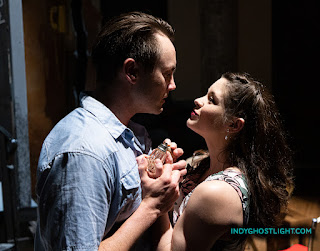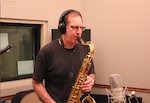Ebene Quartet brings three distinctive major works here on its 20-concert, 25-day tour
The Ebene String Quartet's return visit under Ensemble Music Society auspices Wednesday night confirmed the excellence that the four Frenchmen exhibited here in 2011.
Each of the works performed is highly characteristic (yet boundary-stretching) of its composer, ranging from the adventurous harmonies of Mozart's Quartet in E-flat, K. 428, on through Mendelssohn's weighty String Quartet in A minor, op. 13, No. 2, to Robert Schumann's controlled-bipolar Quartet in A major, op. 41, no. 3.
Starting with the Schumann, which had the second half of the program at Indiana History Center to itself, the Ebene Quartet exemplified the French virtues of clarity and order. That didn't keep them from emphasizing the German composer's skill at projecting the two contrasting sides of his personality, however. The daydreaming first-movement themes, for example, are at times supported by lightly agitated accompaniment, at one point briskly syncopated.
The startling vigor generated in the theme-and-variations second movement was fully engaged. At the other end of the spectrum, the oddly endearing lyricism of the slow movement — surely loaded with the hazards of dullness in merely dutiful hands — captured our rapt attention. That sustained vitality made the sometimes frenetic finale all the more exciting.
Sitting first chair, violinist Pierre Colombet's patrician, commanding tone successfully embraced the work's passion, just as it had been a model of classical restraint in the Mozart quartet. He changed places with the Ebene's other violinist, Gabriel Le Magadure, for the Mendelssohn piece. Le Magadure's more melting sonorities and gift for caprice were perfect to bring forward the "Ist es wahr" quartet's youthful abandon. He was especially effective in the Intermezzo, with a theme that — like an Irving Berlin tune — gives the miraculous impression of having always "been there."
I enjoyed the dignified stature of Mathieu Herzog's playing whenever it stood out from his colleagues'. His manner was well-suited to the viola's more typical middle position aiding the ensemble bond. But it was fun to hear him enunciate the "bridge" melody in the encore, the Ebene's refreshing arrangement of Errol Garner's "Misty."
Cellist Raphael Merlin was remarkable as he epitomized the Ebene's consistent grace. He had the most efficient performing motion, with nothing extraneous or wasteful, of any cellist I have seen since Janos Starker. Yet he was fully capable of contributing a mighty baritone voice when the ensemble was in full cry.
In the Mozart, while I liked the understatement given the harmonic tension in the first and second movements, the "Andante con moto" seemed too slow. At that pace, a less precise and coordinated group would have sounded listless, but the Ebene removed itself comfortably from that danger.
Occupying the highest plane, if the most sustained excellence has to be mentioned, was the Mendelssohn performance. The work is one of the most ambitious examples of the fully formed teenage composer's genius. Without magniloquence or preening, the young Mendelssohn could display his astonishing gifts with exquisite craftsmanship and a daring insouciance. And the Ebene proved itself fully up to such a display as this work almost uniquely affords.
 |
| The Ebene Quartet made its second appearance here Wednesday. |
Each of the works performed is highly characteristic (yet boundary-stretching) of its composer, ranging from the adventurous harmonies of Mozart's Quartet in E-flat, K. 428, on through Mendelssohn's weighty String Quartet in A minor, op. 13, No. 2, to Robert Schumann's controlled-bipolar Quartet in A major, op. 41, no. 3.
Starting with the Schumann, which had the second half of the program at Indiana History Center to itself, the Ebene Quartet exemplified the French virtues of clarity and order. That didn't keep them from emphasizing the German composer's skill at projecting the two contrasting sides of his personality, however. The daydreaming first-movement themes, for example, are at times supported by lightly agitated accompaniment, at one point briskly syncopated.
The startling vigor generated in the theme-and-variations second movement was fully engaged. At the other end of the spectrum, the oddly endearing lyricism of the slow movement — surely loaded with the hazards of dullness in merely dutiful hands — captured our rapt attention. That sustained vitality made the sometimes frenetic finale all the more exciting.
Sitting first chair, violinist Pierre Colombet's patrician, commanding tone successfully embraced the work's passion, just as it had been a model of classical restraint in the Mozart quartet. He changed places with the Ebene's other violinist, Gabriel Le Magadure, for the Mendelssohn piece. Le Magadure's more melting sonorities and gift for caprice were perfect to bring forward the "Ist es wahr" quartet's youthful abandon. He was especially effective in the Intermezzo, with a theme that — like an Irving Berlin tune — gives the miraculous impression of having always "been there."
I enjoyed the dignified stature of Mathieu Herzog's playing whenever it stood out from his colleagues'. His manner was well-suited to the viola's more typical middle position aiding the ensemble bond. But it was fun to hear him enunciate the "bridge" melody in the encore, the Ebene's refreshing arrangement of Errol Garner's "Misty."
Cellist Raphael Merlin was remarkable as he epitomized the Ebene's consistent grace. He had the most efficient performing motion, with nothing extraneous or wasteful, of any cellist I have seen since Janos Starker. Yet he was fully capable of contributing a mighty baritone voice when the ensemble was in full cry.
In the Mozart, while I liked the understatement given the harmonic tension in the first and second movements, the "Andante con moto" seemed too slow. At that pace, a less precise and coordinated group would have sounded listless, but the Ebene removed itself comfortably from that danger.
Occupying the highest plane, if the most sustained excellence has to be mentioned, was the Mendelssohn performance. The work is one of the most ambitious examples of the fully formed teenage composer's genius. Without magniloquence or preening, the young Mendelssohn could display his astonishing gifts with exquisite craftsmanship and a daring insouciance. And the Ebene proved itself fully up to such a display as this work almost uniquely affords.



Comments
Post a Comment